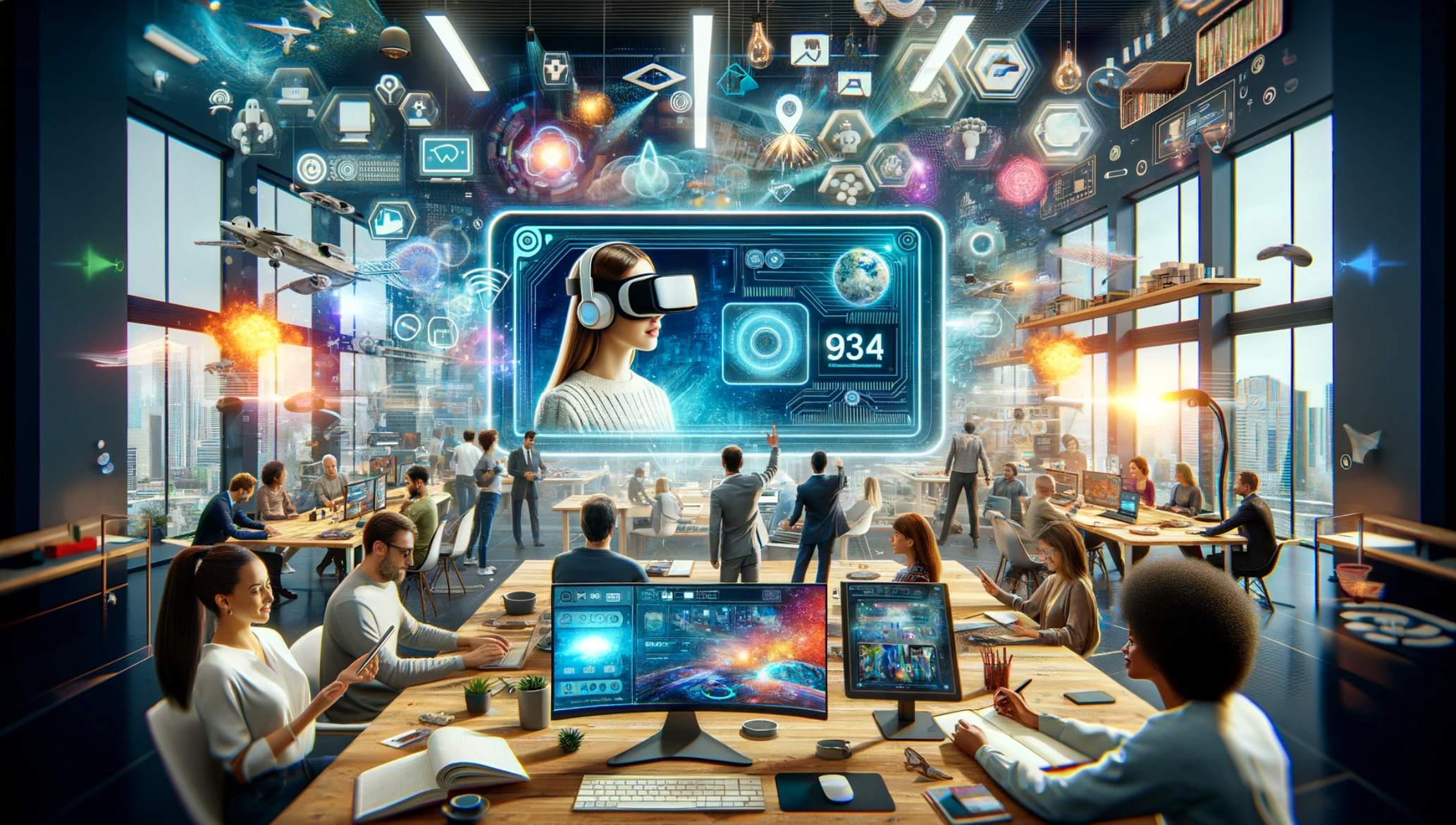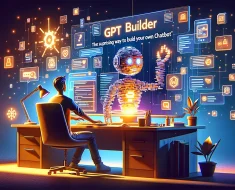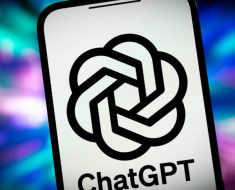
As we step into 2024, the digital landscape is evolving at an unprecedented pace, and at the forefront of this transformation is ChatGPT.
This advanced AI model, developed by OpenAI, is not just another tool in the tech arsenal; it’s a game-changer in the realm of content creation.
In this post, we’ll explore how ChatGPT is revolutionizing the field of content creation, making things easier, more efficient, and incredibly innovative.
Understanding ChatGPT
Before diving into its impact on content creation, let’s understand what ChatGPT is. ChatGPT is a variant of the GPT (Generative Pre-trained Transformer) model, specifically designed to generate human-like text.
It’s like having a digital brain that can converse, compose, and create content with human-like flair.
The Revolution in Content Creation
Enhanced Efficiency and Productivity
The integration of ChatGPT into content creation processes marks a significant shift in how content is generated, managed, and delivered. This shift is characterized by increased efficiency and productivity, which can be broken down into several key aspects:
Accelerated Content Generation
Rapid Drafting
With ChatGPT, the time it takes to produce a first draft of any content piece is drastically reduced. Whether it’s articles, blog posts, or scripts, ChatGPT can generate coherent and structured drafts in a matter of minutes. This capability is especially beneficial for meeting tight deadlines and handling large volumes of content.
Idea Generation
Sometimes, the hardest part of content creation is getting started. ChatGPT aids in overcoming writer’s block by suggesting topics, titles, and even outlines. This feature enables content creators to jumpstart their creative process without the initial struggle.
Streamlined Content Workflow
Integration with Tools
ChatGPT can be integrated into various digital platforms and content management systems (CMS). This integration allows for a more streamlined workflow, where ideas can be quickly transformed into published content without the need for multiple intermediate steps.
Automation of Repetitive Tasks
ChatGPT excels at automating repetitive and time-consuming tasks like formatting, summarizing lengthy documents, or translating content into different languages. This automation frees up valuable time for content creators to focus on more creative and strategic aspects of their work.
Consistency and Scalability
Uniform Quality
Maintaining a consistent tone and quality across all content is a challenge, especially for larger teams or when outsourcing. ChatGPT provides a level of consistency in writing style and quality, ensuring that all content aligns with brand guidelines and voice.
Scalable Content Production
ChatGPT’s ability to quickly generate content enables scalability in content production. Businesses can ramp up their content output as needed without a corresponding increase in resources or time investment.
Enhanced Research and Data Handling
Efficient Data Compilation
ChatGPT can rapidly compile and summarize information from various sources, making the research process much more efficient. This capability is particularly useful for content that requires extensive background research or data analysis.
Up-to-Date Information
ChatGPT, when connected to current data sources, can generate content that includes the most recent information and trends. This feature is crucial for industries where staying up-to-date is essential, such as news, technology, and finance.
Collaborative Content Creation
Team Collaboration
ChatGPT can act as a collaborative tool, assisting teams in brainstorming sessions, providing suggestions, and even refining content collaboratively. This collaboration ensures that the final content is a result of combined human creativity and AI efficiency.
Feedback Incorporation
ChatGPT can be used to incorporate feedback into content quickly.
Whether it’s revising drafts based on editor comments or adapting content based on audience response, ChatGPT can streamline the revision process.
ChatGPT’s impact on enhancing efficiency and productivity in content creation is multifaceted. From speeding up the drafting process to streamlining workflows and ensuring consistency, ChatGPT is transforming the landscape of content creation. It allows creators to focus more on innovation and strategy, while the AI handles the heavy lifting of drafting, research, and repetitive tasks.
This synergy between human creativity and AI efficiency is paving the way for a new era in content creation, one where ideas can be turned into impactful content faster and more effectively than ever before.
Improved Quality and Creativity
The introduction of ChatGPT into the content creation process doesn’t just speed things up; it also significantly enhances the quality and creativity of the output. This improvement can be attributed to several factors:
High-Quality Content Generation
Advanced Language Understanding
ChatGPT’s training on diverse and extensive datasets enables it to understand and use language at a level that mirrors human expertise. This understanding is critical in producing content that is not only grammatically correct but also contextually relevant and engaging.
Factually Accurate and Informative
With its vast knowledge base, ChatGPT can generate content that is not only well-written but also factually accurate and informative. This aspect is particularly valuable for educational, technical, and news-related content, where accuracy is paramount.
Enhanced Creativity in Content
Diverse Perspectives
ChatGPT can offer multiple viewpoints on a given topic, thanks to its exposure to a wide range of texts and writing styles. This diversity enables content creators to explore different angles and approaches, enriching the creative process.
Generating Unique Ideas
Beyond just writing, ChatGPT can be a source of unique and innovative ideas. Whether it’s suggesting unusual combinations, thinking outside the box for marketing campaigns, or proposing novel topics for blogs, ChatGPT can push the boundaries of conventional thinking.
Tailored Content for Different Mediums
Adapting to Various Formats
ChatGPT’s flexibility in generating content for different mediums – be it social media posts, long-form articles, scripts for videos, or even interactive chatbots – ensures that the content is not only high-quality but also suitable for its intended platform.
Style Customization
ChatGPT can adjust its writing style to match specific requirements, whether it’s formal, casual, technical, or whimsical. This customization ensures that the tone and style of the content align with the target audience and platform.
Overcoming Creative Blockades
Inspirational Prompts
For content creators facing writer’s block, ChatGPT can serve as a source of inspiration. It can provide prompts, start off stories, suggest headlines, or even offer complete paragraphs to kickstart the creative process.
Expanding on Ideas
ChatGPT can help flesh out incomplete ideas or expand on brief outlines. This ability is particularly useful in developing comprehensive and well-rounded content from mere concepts or bullet points.
Refining and Polishing Content
Editing and Proofreading
ChatGPT can assist in editing and proofreading content, ensuring that the final product is polished, coherent, and free of errors. This step is crucial in maintaining the quality and professionalism of the content.
Providing Constructive Feedback
ChatGPT can offer constructive feedback on written content, suggesting improvements in structure, style, and clarity. This feature is valuable for refining content and enhancing its overall impact.
ChatGPT’s role in improving the quality and creativity of content is multifaceted. It elevates the standard of content creation by ensuring high-quality, accurate, and engaging outputs.
Simultaneously, it boosts creativity, offering new perspectives and ideas, adapting to various formats and styles, and assisting in overcoming creative hurdles. By merging AI capabilities with human creativity, ChatGPT not only enriches the content creation landscape but also opens up new avenues for innovative and impactful content.
Personalization and Targeting
Content personalization and precise targeting have become crucial for engaging audiences effectively. ChatGPT plays a significant role in achieving this by leveraging its advanced AI capabilities. Here’s how:
Tailored Content for Specific Audiences
Understanding Audience Preferences
ChatGPT can analyze data on audience preferences and behaviors. This analysis enables it to generate content that resonates with specific demographic groups, interests, or consumer behaviors, ensuring a higher engagement level.
Customized Messaging
With its ability to understand and replicate different writing styles and tones, ChatGPT can create content that feels more personalized and relevant to individual readers or viewer segments. This customization increases the relevance and appeal of the content.
Dynamic Content Adaptation
Real-time Adaptation
ChatGPT can modify content in real-time based on changing audience responses or trends. This dynamic adaptation ensures that the content remains relevant and engaging, even in rapidly evolving scenarios.
Feedback Incorporation
By analyzing user feedback and engagement metrics, ChatGPT can refine and adjust content to better meet audience needs and preferences. This ongoing optimization process helps in maintaining a strong connection with the audience.
Enhanced Segmentation
Detailed Audience Segmentation
ChatGPT’s ability to process and analyze large datasets allows for detailed audience segmentation. Content can be tailored to cater to the nuances of each segment, whether based on geographical location, age group, interests, or browsing behaviour.
Niche Content Creation
For niche markets or specialized topics, ChatGPT can generate highly specialized content. This capability is invaluable for targeting specific groups that require a deep understanding of particular subjects or industries.
Improved Engagement and Conversion
Persuasive and Relevant Content
By creating content that speaks directly to the needs and interests of the audience, ChatGPT helps in crafting more persuasive and compelling narratives. This relevance not only enhances engagement but also increases the likelihood of conversion.
Interactive and Responsive Content
ChatGPT can be used to create interactive content like quizzes, personalized recommendations, or chatbots that respond to user input. This interactivity adds a layer of personal engagement, making the content more captivating and memorable.
Leveraging Data for Personalization
Data-Driven Insights
ChatGPT, combined with analytics tools, can glean insights from user data to inform content strategy. This data-driven approach ensures that content is not only personalized but also strategically aligned with audience preferences.
Predictive Content Creation
Using predictive analytics, ChatGPT can anticipate future trends and audience needs, enabling content creators to stay ahead of the curve. This foresight is crucial in maintaining relevance and engagement over time.
ChatGPT’s impact on personalization and targeting in content creation is profound. By understanding and adapting to audience preferences, enabling dynamic content adaptation, and leveraging data for insightful segmentation and engagement, ChatGPT is transforming how content is crafted and consumed.
It allows for a level of personalization and precision in targeting that was previously challenging to achieve, making content not just informative or entertaining but also deeply resonant and impactful for the intended audience.
ChatGPT in Various Content Domains
Blogging and Article Writing
In the realm of blogging, ChatGPT is a powerhouse. It can help bloggers generate ideas, outlines, and even entire posts. Additionally, it can assist in SEO optimization, ensuring that the content ranks well in search engines.
Marketing and Advertising
For marketers, ChatGPT is a dream come true. It can generate catchy headlines, compelling ad copy, and even help in email marketing campaigns by creating personalized content for different segments of the audience.
Educational and Instructional Content
In education, ChatGPT can be used to create instructional materials, tutorials, and even interactive learning modules. Its ability to break down complex concepts into easy-to-understand content makes it an invaluable tool for educators.
Overcoming Challenges
Ethical Considerations
As with any AI technology, ethical considerations are paramount. It’s crucial to use ChatGPT responsibly, ensuring that the content generated is not misleading or harmful.
Maintaining a Human Touch
While ChatGPT is incredibly efficient, maintaining a human touch in content is essential. It’s about finding the right balance between AI-generated content and human creativity.
The Future of ChatGPT in Content Creation
Advanced AI Integration and Learning
Continuous Learning and Evolution
As AI technologies evolve, ChatGPT is expected to become even more sophisticated in its learning and understanding. This continuous evolution will likely result in more nuanced and context-aware content generation, closely mirroring human cognitive processes.
Enhanced Natural Language Understanding
Future versions of ChatGPT could exhibit a deeper comprehension of human languages, idioms, cultural nuances, and emotional undertones. This advancement will allow for the creation of content that is not only grammatically and factually accurate but also emotionally resonant and culturally sensitive.
Integration with Emerging Technologies
Virtual Reality (VR) and Augmented Reality (AR)
Integrating ChatGPT with VR and AR technologies could lead to the creation of immersive and interactive content experiences. Imagine virtual worlds or augmented reality scenarios where content is dynamically generated and personalized by ChatGPT in real-time.
Internet of Things (IoT)
In an IoT-connected world, ChatGPT could play a pivotal role in generating content for smart devices, adapting to user behaviors, and creating more personalized and contextually relevant user experiences.
Enhanced Personalization and Predictive Analysis
Hyper-Personalized Content
Future iterations of ChatGPT might offer hyper-personalized content creation, tailored not just to demographic groups but to individual user preferences and behaviors, based on real-time data and predictive analytics.
Predictive Content Strategies
Leveraging advanced analytics, ChatGPT could help content creators and marketers anticipate future trends and audience needs, allowing for the creation of content that addresses emerging interests and concerns.
Expanding Creative Horizons
Generating Complex Creative Works
As ChatGPT becomes more sophisticated, its potential in generating complex creative works like novels, screenplays, or music compositions could be realized. This capability would open new horizons in collaborative human-AI art and storytelling.
Enhanced Brainstorming and Ideation
With a deeper understanding of creative processes, ChatGPT could become an invaluable tool for brainstorming and ideation, helping creators explore uncharted territories in their creative endeavors.
Ethical and Responsible AI Use
Addressing Ethical Concerns
As ChatGPT becomes more integral to content creation, the ethical implications of AI-generated content will become increasingly important. Ensuring responsible use, transparency, and addressing issues like bias and misinformation will be imperative.
Enhancing Human-AI Collaboration
The future of ChatGPT in content creation is not about replacing human creativity but augmenting it. Developing frameworks for effective human-AI collaboration will be key in harnessing the full potential of ChatGPT while retaining the irreplaceable value of human insight and creativity.
The future of ChatGPT in content creation looks incredibly promising, with potential advancements in AI learning, integration with cutting-edge technologies, enhanced personalization, creative capabilities, and a focus on ethical AI use.
These developments will not only revolutionize how content is created but also how it is experienced, making it more dynamic, personalized, and impactful. The synergy between human creativity and AI efficiency will continue to redefine the boundaries of what’s possible in content creation.
Conclusion
The revolution that ChatGPT brings to content creation in 2024 is just the beginning. Its efficiency, creativity, and ability to personalize content are transforming how we create and consume digital content. As we embrace this AI-driven future, the possibilities for content creation are truly limitless.
*****
*Remember, the future of content creation is not about replacing human creativity but augmenting it with the power of AI.





